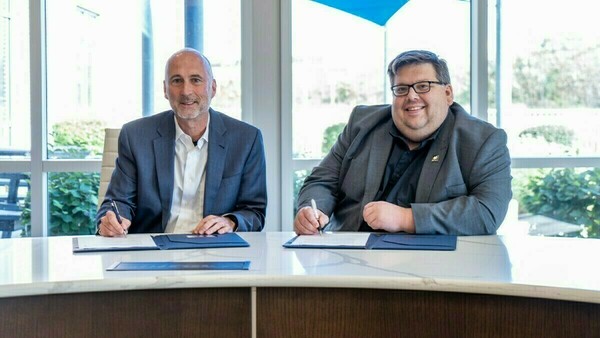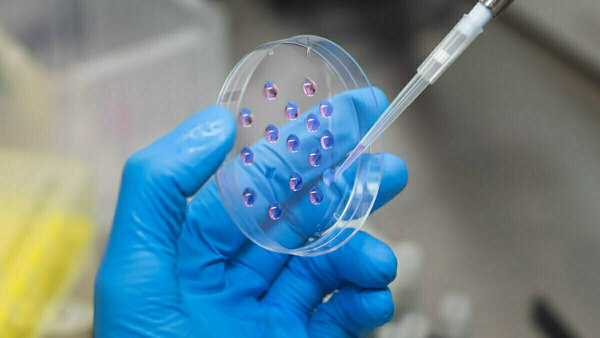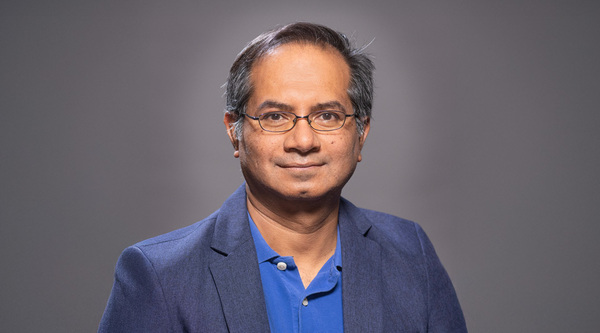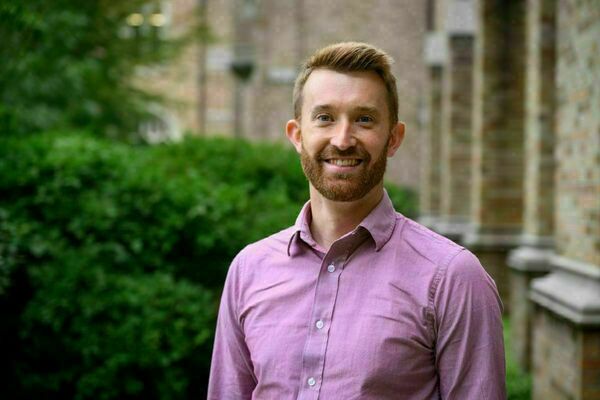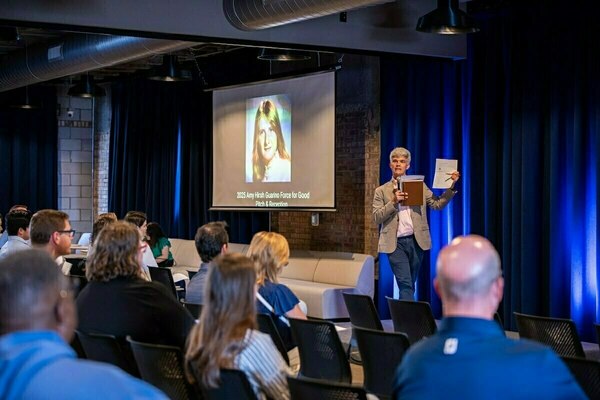This Reluctant Entrepreneur’s Research Breakthrough Is Now a Game-Changing Spinal Implant
| Company Founded: | HAPPE Spine, LLC | Year Founded: | 2019 |
|
Title: |
Co-Founder, Board Member + CTO | Notre Dame Faculty: | 2001 to Present |
Ryan Roeder began college with no intention of going to graduate school.
He began graduate school with no intention of becoming a professor.
He became a professor with no intention of becoming an entrepreneur and founding a startup with disruptive technology.
But here he is with a PhD in Materials Engineering, 23 years deep in an academic career as a University of Notre Dame professor in the Department of Aerospace and Mechanical Engineering, and founder and chief technology officer of HAPPE Spine. In mid-August, Roeder watched his co-inventor in HAPPE Spine and South Bend neurosurgeon, Dr. Stephen Smith, successfully implant their novel cervical interbody fusion device in their first patient. A limited user national launch of the INTEGRATE®-C Interbody Fusion System is set to follow later this year.
The seeds for this reluctant entrepreneur may have been planted in his upbringing on a family farm.
Roeder explains. “I grew up on a family farm, mainly corn and soybeans, in Bremen, Indiana. I saw my father and grandfather make important business decisions and sweep the shop floor the same day. Entrepreneurs have a similar mindset. Another similarity is that both take risks, whether to put crops in the fields or new products on the market.”
The farm instilled in Roeder an interest in all things mechanical, but while attending Purdue University, he was surprised by how much he liked his chemistry classes. “I had no idea what materials science and engineering were as a kid, but took a risk on majoring in Materials Engineering, which applies chemistry and physics to design and create materials for all types of technology. I thought it could be an interesting career path.”
Then something unexpected happened. A summer research experience led him to pursue graduate school. “I liked the independence of working in a research lab and the freedom to explore new ideas. Compared to that, an entry-level industry job seemed boring to me,” he says.
Another unexpected thing happened. “In graduate school I realized that I enjoyed teaching and found it rewarding to invest in the development of people, rather than just technology.” So Roeder decided to take a risk on an academic career.
Roeder’s PhD research focused on low temperature synthesis of microelectronic materials, but he was most fascinated with biomedical applications of materials science. This led him to accept a post-doctoral fellowship in Orthopedic Surgery at the Indiana University School of Medicine in Indianapolis in 1999. While this may seem like an unexpected path, Roeder had another good reason for a medical school post-doc.
“My wife was finishing up her medical degree at Indiana University, which made the post-doc attractive.” Though he didn’t know it at the time, it also teed up his future startup, HAPPE Spine.
While completing his post-doc, Roeder turned his attention to finding a faculty position. At the time, Notre Dame was not on the list of engineering schools he was considering. However, collaboration with a group of Notre Dame faculty working on an orthopedic focused 21st Century Fund Grant from the State of Indiana changed his mind.
“A large part of Notre Dame’s attraction to me was seeing the university’s potential to grow research in a big way, which I’ve now witnessed over the last two decades. So when our collaborators told me they had an opening and suggested that I apply, I jumped on it.”
From 2001 up until 2012, much of Roeder’s research centered on studying bone and biomaterials that integrate with bone and even act like bone. One such biomaterial seemed ideal for interbody spinal fusion. The clinical goal of spinal fusion is pain relief for patients where a degenerated or herniated intervertebral disc is causing compression on nerve roots and the spinal cord.
“Interbody fusion devices act as a spacer in the disc space to re-establish the proper anatomy, which is then maintained by encouraging bone to grow between adjacent vertebrae and fuse them together,” Roeder explains.
Mainstream interbody fusion implants were first made from titanium, but the rigidity of titanium shields the disc space from biomechanical loads that stimulate bone growth. Titanium implants also inhibit imaging, making it difficult for physicians to assess healing and fusion progression. Around 2000, titanium was largely replaced in interbody fusion implants by a plastic called polyetheretherketone (PEEK), because it’s less rigid in transferring biomechanical loads to the disc space and is radiolucent to allow imaging. PEEK’s limitation is that it does not integrate with bone but instead is encapsulated by fibrous tissue.
“My idea was to modify PEEK to integrate with bone. We added porosity to draw blood and other autologous factors into the implant to promote rapid healing and bone in-growth. We also added calcium phosphate crystals that are exposed on all material surfaces to promote cell signaling and bone on-growth. Once placed in a patient, the implant looks and acts more like bone,” Roeder explains.
“We also recognized the importance of being able to image both the implant and the growth of new bone without disruption from the implant. This part of our value proposition has been heightened with the rise of artificial intelligence and data-driven pre-operative planning, which require quality imaging data. You just can’t get a comparable radiograph or CT scan with a titanium implant. With our biomaterial platform, physicians will be able to better collect data and assess outcomes,” he adds.
Roeder’s idea and initial research in the early 2000’s when PEEK implants were still new to the market and no one else was thinking about this approach. There simply was no market interest. Notre Dame was very supportive of his work, but the lack of commercial interest in licensing put the university and Roeder at a crossroads in 2013. They could let the technology fade away or release rights to the inventors.
Roeder moved forward rallying his co-inventors, former Notre Dame graduate student Dr. Gabriel Converse and a local neurosurgeon Dr. Stephen Smith, along with three partners with spine industry experience, to establish Spinesmith, LLC, as a holding company. For the next six years, they worked to protect the intellectual property while waiting and hoping on the market to come to them.
And like the reluctant entrepreneur that was Roeder, the reluctant market became ripe for his innovation.
First, a prominent material supplier released a new product with calcium phosphate added to PEEK, but no porosity. Then 3D printing of titanium implants awakened surgeons to the value of porous implants, but still with many of the old problems of titanium. Another startup company launched a successful PEEK interbody implant with limited porosity, but no calcium phosphate. The stage was now set for a PEEK interbody fusion implant with fully integrated porosity and calcium phosphate.
In 2019, Roeder and Spinesmith partnered with the Genesis Innovation Group of Grand Rapids, Michigan, to co-found HAPPE Spine, LLC. The name is an acronym for the material platform Roeder invented: HydroxyApatite Porous PolyEtheretherketone. The goal of the new partnership was to accelerate commercialization, but two heavy lifts stood in their path: fundraising and FDA clearance.
Fundraising began in 2019 with $2.2 million in seed funding raised from the co-founders t and a venture capital fund managed by Genesis Innovation Group. For series A funding, Roeder and his team expanded their investors to include strategic spine industry partners, raising $7.3 million from 2021 to present.
“The initial series A round was done in the middle of COVID shutdowns. I did many, many of Zoom meetings with investors as well as surgeons for customer validation. Investors and surgeons were all extremely enthusiastic, which affirmed what we already believed about our technology,” Roeder says.
The influx of funding enabled Roeder and team to address FDA clearance, a costly and time-consuming process. Thanks to the recent incremental developments in interbody spinal fusion devices made from PEEK and 3D printed titanium, they were able to pursue the FDA 510(k) pathway, which would not require clinical trials. HAPPE also mitigated risk by initially pursuing a cervical (neck) device for market entry rather than more challenging lumbar (lower back) devices. All HAPPE Spine had to do was prove equivalency to existing cervical devices. Easy, right?
Not quite, says Roeder. “Even though we used the FDA 510(k) pathway based for equivalency with previously approved predicate devices made from the same materials, the FDA required that we do mechanical and biocompatibility testing on our device and material. It was costly and time consuming. After a couple years of careful preparation, the formal review took a little more than nine months. We received FDA clearance to use our implant in patients in May 2023.”
There was little time to celebrate as HAPPE Spine had to expand its manufacturing capacity and build inventory to support commercial sales.
“From January to May we didn’t yet have clearance from the FDA but were working feverishly on our manufacturing capabilities. We actually began production before receiving the clearance notification,” he says.
The decision was made to launch the HAPPE Spine INTEGRATE®-C Interbody Fusion System at South Bend’s Beacon Health System. Dr. Smith would perform the surgery. “As the co-inventor, Steve has been the most engaged clinical voice for our product, so it was logical he would do the first implant,” Roeder says.
The surgery went off without a hitch, and two weeks post-surgery, the patient reported being pain free. The news was incredibly gratifying for Roeder as so few academic researchers get to this point. “As an engineer, I am very fortunate to see the results of my research in a patient. I primarily love doing the science and engineering, but the added reward in biomedicine is knowing you are actually helping someone have a better life.”
As with achieving FDA clearance, the celebration of the first patient has been short lived. HAPPE Spine is looking to a more extensive yet very deliberate national rollout through the remainder of this year and into 2024. Roeder says the initial clinical sites will be a combination of academic medical centers with key opinion leaders and surgery centers that will help drive revenue. “We don’t want to overextend ourselves. We want to do it right by validating our product with clinical data and pacing growth in our organizational capabilities.”
Roeder is extremely grateful for the incredible support given by Notre Dame over the years. “The university has no financial stake in HAPPE Spine, yet they see a win for HAPPE as a win for Notre Dame. The university wants to see faculty innovation and has shown a willingness to empower us to be successful. We have an incredible story with HAPPE that is not yet finished.”
Asked how he’d advise other inventor-entrepreneurs considering a startup and Roeder, the reluctant entrepreneur, had this to say:
“First, if you’re an academic or licensing university technology, realize that most of what academic researchers do is probably 10 to 20 years ahead of the market. The journey ahead will require a lot of patience. Second, as a founder, you will initially own 100 percent of something worth next to nothing. You have to carefully balance a desire for control with a need for expertise and resources that most founders don’t have. Third, if you really believe in what you’re doing, invest your own money in it. Do so wisely because you have to be OK with potentially losing every dollar you put in. That said, why not bet on yourself?”
Originally published by at ideacenter.nd.edu on September 27, 2023.
Latest Research
- Notre Dame, Beacon Health System announce new, multiyear research collaborationThe University of Notre Dame and Beacon Health System have announced a new, multiyear research collaboration. Through this agreement, Notre Dame and Beacon will jointly develop collaborative, health-focused research projects that are of interest to both organizations, particularly in the areas of oncology and health data.
- Fighting to cure brain cancerTo better understand glioblastoma, an aggressive brain cancer, a Notre Dame researcher thought outside the box—and off planet Earth. Read the story
- ND electrical engineer Ranjan Singh named founding editor-in-chief of APL Engineering PhysicsRanjan Singh, professor of electrical engineering at the University of Notre Dame and pioneer in terahertz photonics, spintronics and metamaterials, has been named founding editor-in-chief of Applied Physics Letters (APL) Engineering Physics.
- Exceptional faculty recognized as Notre Dame’s 2025 All-Faculty TeamNotre Dame has a long history of outstanding student-athletes being named to All-America teams. The University also has a tradition of honoring exceptional faculty on the football field each fall. At every home game, the provost honors a distinguished member of the faculty. These seven scholar-teachers…
- Localizing global environmental challenges through Just Transformations to Sustainability InitiativeThis story is part of a series of features highlighting the managing directors of the University's strategic initiatives. The managing directors are key (senior) staff members who work directly with the faculty…
- Career planning platform Runwayz takes home the Amy Hirsh Guarino AwardOn Friday, September 19, members of the University of Notre Dame and South Bend communities gathered to celebrate the legacy of Amy Hirsh Guarino by recognizing a local venture that best embodies the ideals of the University and reflects Amy's values of hard work, helping others, innovation, and community service.








